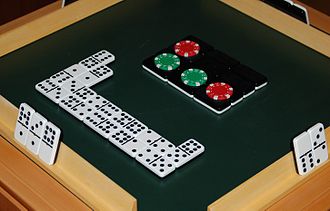Bukidomino

Bukidomino , six dominoes , also written Buki-Domino , Bookie-Domino or Booky-Domino , or Buki for short is a game of chance that was played a lot in Vienna at the beginning of the 20th century.
The Bukidomino was mentioned in literature by Joseph Roth ( Zipper and his father ), Egon Erwin Kisch ( leather industry in gleanings ), but above all in the 15th chapter of the novel Between nine and nine by Leo Perutz , which in its entirety contains the precise description of a Bukidomino. Lot is dedicated. The following description is based on the references given in Perutz's novel and on the sources cited in the bibliography.
Game description
Four players play a game of "normal dominoes "; What is meant is a block domino for four people. Dominoes used to be played with 36 pieces in Austria: you took the 45 pieces from a double-eight game and removed the nine double pieces (0-0, 1-1 to 8-8). The stones are shuffled face down by the game master, the buki or banker , each player receives six stones, the banker uses himself last. The remaining stones form the trunk and are not used in the course of the game.
The booky or six dominoes are on the list of prohibited games of the Imperial and Royal Justice Ministry : In contrast, according to Beck, the Buki game with seven stones per player was not viewed as a game of chance and was tolerated by the authorities.
The first game of a game begins with the player who has the highest stone, i.e. H. stone 8–7, if it is not in the trunk. After the first player, the other players each place a stone one after the other; The game is played counterclockwise. Anyone who cannot moor must sit out; there is no buying. Whoever has placed all the stones first is the winner. In the case of a blocked game, i. That is, if none of the four players can moor, the player who has the fewest eyes in his hand wins.
Before each game, in addition to the players involved, the spectators, lapwings or gallery owners can also bet on one of the four active players - or, according to Unger and Beck: on one of the banker's three opponents. These bets are placed at the Buki .
The name Buki is derived from English. bookie ( spelled less often booky ), the abbreviation for bookmaker . Around 1900, the English term bookmaker was in use in horse racing , the German term bookmaker only caught on later. The connection to horse betting is made clear in Perutz's novel, on the one hand, by the reference that players are betting “like racing horses”, and on the other hand, Perutz lets this episode play in Café Turf .
Win odds and bank advantage
If the player you bet on wins , you receive " triple money " from the Buki . As is evident from Perutz's description is clear, so that is a win ratio of 2: meaning 1: After Stanislaus Demba, the main character of the novel, 10 crowns has set and won, has he 30 crowns, so its profit is only 20 crowns. Then he leaves stakes and profits - he puts " money on money " - and wins again, which increases his fortune to 90 kroner. After another win he owns 270 crowns and is then cheated out of the win and the original stake by the Buki .
Since the Buki only pays a rate of 2: 1 instead of the fair rate of 3: 1 in the event of a win, he wins an average of 25 percent of the bets made ( bank advantage ). Beck gives a win rate of 2½: 1, the bank advantage is then 12.5 percent.
With these calculations, the - very unrealistic - requirement applies that a player risks the same stake in every single game - regardless of whether he is allowed to place the first stone or not. If the players do not have to place all of their bets before picking up the stones, this improves their chances considerably.
The ratio between the minimum and maximum stake is decisive for the chances of the players, a ratio of 3: 1 between maximum and minimum appears to be appropriate. A small ratio between minimum and maximum favors the banker, a large ratio shifts the advantage in favor of the opponent.
Continuation of the game
The winner of a game has the approach to the next game (i.e., he may place the first stone); he must place his bet before playing the first stone. The other players may - according to Beck - wait with their bets until it is their third turn to place them, or - according to Unger - must make their bets as long as they still have at least five stones.
Others
The game was banned by the Austrian government in early September 1916 under Section 522 of the Austrian Criminal Code.
"Gallery" is a term for the Viennese underworld; this name is derived from the photo album of the police, which is also called the gallery; the people depicted in it are called "gallery owners" (cf. shock )
literature
- Fritz Beck: Dominoes in many varieties , Verlag Perlen Reihe , Vienna 1960
- Leo Perutz: Between nine and nine , dtv
- Franz Unger: Domino, Buki-Domino, Card-Domino, Cooncan. Wenedikt's Spielbücher, 5th edition, Vienna - Leipzig, 1913
Individual evidence
- ↑ http://www.pagat.com/tile/wdom/austrian.html
- ^ Fritz Beck: Domino in many varieties , Verlag Perlen Reihe , Vienna 1960, p. 109
- ↑ http://www.pagat.com/tile/wdom/austrian.html
- ^ Ordinance of the head of the Ministry of the Interior dated September 6, 1916 [1]
- ↑ Peter Wehle : Do you speak Viennese? Vienna 1980